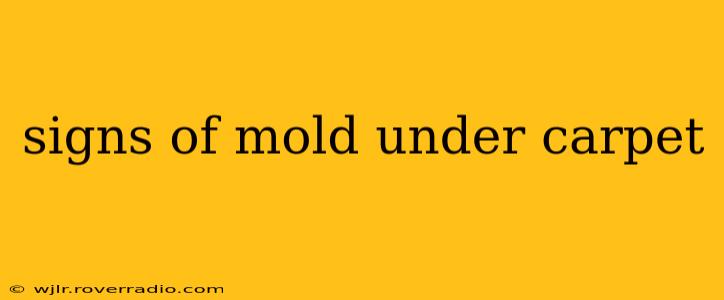Mold growing beneath carpeting is a serious issue, impacting indoor air quality and potentially causing health problems. Detecting it early is crucial, but unfortunately, mold often hides unseen. This guide explores the telltale signs of mold under your carpet, helping you identify a potential problem before it escalates.
What are the signs of mold under carpet?
This is the most common question people have, and rightly so. Mold doesn't announce its presence with a flashing neon sign! Instead, look for these subtle clues:
-
Musty Odor: A persistent, earthy, or musty smell, even after thorough cleaning, is a major red flag. This odor is often the first indication of hidden mold growth. The smell might be localized to a specific area or more widespread, depending on the extent of the mold infestation.
-
Visible Mold: While unlikely to see extensive growth through the carpet itself, you might spot small patches of mold along the edges where the carpet meets the wall, or in areas where water damage is evident. This could be black, gray, green, or even white mold.
-
Discoloration: Check the carpet for unusual staining or discoloration, especially in damp areas. This could be a sign of water damage which is a breeding ground for mold. The discoloration might not be mold itself but an indicator of the moisture allowing mold to thrive.
-
Allergic Reactions: If you or your family members experience increased allergy or asthma symptoms, such as sneezing, coughing, watery eyes, or breathing difficulties, particularly when in a specific room, mold could be the culprit. This is especially true if these symptoms subside when you are away from the house.
-
Dampness or Wet Spots: Feel the carpet for damp or wet spots. This is a clear sign of moisture problems, which create the perfect environment for mold growth. Even if the carpet feels dry on the surface, underlying dampness may still be present.
-
Bubbling or Buckling: The carpet may appear to bubble or buckle in certain areas. This can happen due to moisture build-up beneath the carpet, which can lead to mold growth.
-
Peeling or Lifting of Carpet Edges: If the edges of the carpet are starting to peel or lift, it could signify that moisture has caused damage to the adhesive. This can be a result of underlying mold problems.
How do I know if I have mold under my carpet?
Confirming mold under carpet requires more than just visual inspection. There are a few ways to investigate further:
-
Professional Mold Inspection: The most reliable way to definitively identify and assess the extent of mold growth is to hire a qualified mold inspection professional. They have the tools and expertise to perform thorough testing.
-
Moisture Meter: A moisture meter can detect excess moisture beneath the carpet. While not a direct mold test, it indicates a high-risk environment for mold development.
-
Visual Inspection After Carpet Removal (Caution!): Only remove the carpet if you have appropriate protective gear and ventilation. Mold can release spores that can affect your health.
What causes mold under carpet?
Understanding the root cause of mold growth is critical for remediation:
-
Water Damage: Leaking pipes, floods, or even high humidity are the most common causes of mold under carpet. Moisture provides the ideal conditions for mold spores to germinate and grow.
-
Poor Ventilation: Lack of adequate ventilation traps moisture, creating a damp environment that promotes mold growth.
-
Previous Water Damage: Even if the water damage was addressed previously, hidden moisture could persist and support mold growth over time.
What should I do if I find mold under my carpet?
Discovering mold under your carpet requires prompt action:
-
Professional Remediation: It's generally best to hire a professional mold remediation company. They have the experience and safety measures to properly remove the mold and restore the affected area, preventing future growth. Attempting DIY mold removal can be hazardous.
-
Address Water Source: Before any remediation, the source of the moisture problem must be identified and fixed to prevent future mold growth.
-
Air Quality Monitoring: If mold is present, monitoring the air quality to ensure it's within safe limits is crucial.
How can I prevent mold under carpet?
Prevention is far better than cure:
-
Regular Cleaning: Regularly vacuuming and cleaning your carpets helps prevent moisture buildup.
-
Ventilation: Ensure good ventilation in your home, particularly in areas with carpeted floors. Using exhaust fans and dehumidifiers can help.
-
Prompt Water Damage Repair: Address any water leaks or spills promptly to prevent moisture accumulation.
-
Regular Inspections: Periodically inspect your carpets for any signs of dampness, discoloration, or unusual odors.
By understanding the signs of mold under your carpet and taking proactive steps to address any issues promptly, you can protect your home and family's health. Remember, seeking professional help is always recommended when dealing with mold.
